| Location | Susa, Libya |
|---|---|
| Type | archaeological museum |
| Collection size | ancient Libyan objects, Ptolemaic art |
Apollonia Museum (also known as Susa Museum) is an archaeological museum located in Susa, Libya. Its collection includes ancient Libyan and Ptolemaic sculptures, funerary art, architectural elements, ceramics, and other household items. [1] The museum houses a lot of history that includes Greek and Latin artifacts. [1]
As a harbor for the city of Cyrene, Apollonia was created in the seventh century. The Greek sun god Apollo is the source of the name Apollonia. The Apollonia Museum is home to a large collection of sculptures, busts, heads, columns, ceramics, and other domestic artifacts discovered in the area. [1]

Cyrenaica or Kyrenaika, is the eastern region of Libya. Cyrenaica includes all of the eastern part of Libya between the 16th and 25th meridians east, including the Kufra District. The coastal region, also known as Pentapolis in antiquity, was part of the Roman province of Crete and Cyrenaica, later divided into Libya Pentapolis and Libya Sicca. During the Islamic period, the area came to be known as Barqa, after the city of Barca.
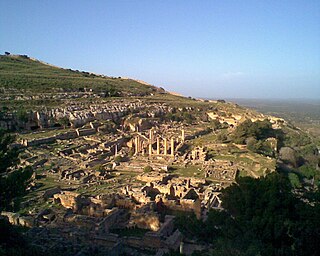
Cyrene, also sometimes anglicized as Kyrene, was an ancient Greek colony and Roman city near present-day Shahhat in northeastern Libya in North Africa. It was part of the Pentapolis, an important group of five cities in the region, and gave the area its classical and early modern name Cyrenaica.

The Palace Museum is a large national museum complex housed in the Forbidden City at the core of Beijing, China. With 720,000 square metres, the museum inherited the imperial royal palaces from the Ming and Qing dynasties of China and opened to the public in 1925 after the last Emperor of China was evicted.

Bayda, or Elbeida ( or ; Arabic: البيضاء al-Bayḍāʾ ), is a commercial and industrial city in eastern Libya. It is located in northern Cyrenaica. With a population of 250,000 people, Bayda is the 4th-largest city in Libya. It is the capital city of the Jabal al Akhdar district.

Ptolemais was one of the five cities that formed the Pentapolis of Cyrenaica, the others being Cyrene, Euesperides, Tauchira/Teuchira, and Apollonia.
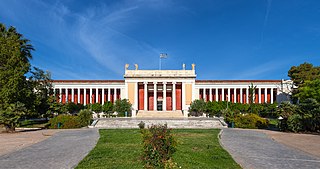
The National Archaeological Museum in Athens houses some of the most important artifacts from a variety of archaeological locations around Greece from prehistory to late antiquity. It is considered one of the greatest museums in the world and contains the richest collection of Greek Antiquity artifacts worldwide. It is situated in the Exarcheia area in central Athens between Epirus Street, Bouboulinas Street and Tositsas Street while its entrance is on the Patission Street adjacent to the historical building of the Athens Polytechnic university.

Apollonia in Cyrenaica was founded by Greek colonists and became a significant commercial centre in the southern Mediterranean. It served as the harbour of Cyrene, 20 km (12 mi) to the southwest.

The Peshawar Museum is a museum located in Peshawar, capital of Pakistan's Khyber Pakhtunkhwa province. The Peshawar Museum is notable for its collection of Buddhist artwork dating from the ancient Gandhara region.

Museo Barracco di Scultura Antica is a museum in Rome, Italy, featuring a collection of works acquired by the collector Giovanni Barracco, who donated his collection to the City of Rome in 1902.

Tourism in Libya is an industry heavily hit by the Libyan Civil War. Before the war tourism was developing, with 149,000 tourists visiting Libya in 2004, rising to 180,000 in 2007, although this still only contributed less than 1% of the country's GDP. There were 1,000,000 day visitors in the same year. The country is best known for its ancient Greek and Roman ruins and Sahara desert landscapes.
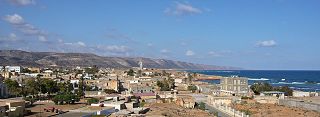
Susa or Soussa is a town and seaside resort in the District of Jabal al Akhdar in north-eastern Libya. Susa stands by the ruins of Apollonia, Cyrenaica. The town contains the Apollonia Museum. It is located about 30 km northeast of Bayda.
The Extramural Sanctuary of Demeter and Persephone at Cyrene, Libya is located on a coastal plateau of Libya, beyond the boundaries of the city (extramural). In approximately 630 BC Greeks from the island of Thera colonized Cyrene. Other Greek colonists not long after increased the population, thus transforming Cyrene into what was regarded as both the largest and wealthiest Greek colony of North Africa. Archaeological excavations of Cyrene's Extramural Sanctuary of Demeter and Persephone, also known as Kore, daughter of Demeter and legendary Queen of the Underworld and consort of Hades, began in 1969 under the sponsorship of the University of Michigan. Between 1973 and 1981 the University of Pennsylvania Museum of Archeology and Anthropology continued the excavations at Cyrene under the direction of Professor Donald White. Following the renewal of relations between Libya and the United States in 2004, the Cyrenaica Archaeological Project (CAP), under the direction of Professor Susan Kane of Oberlin College, was granted permission to resume the work of its predecessors.

The Fleming Museum of Art is a museum of art and anthropology at the University of Vermont in Burlington, Vermont. The museum's collection includes around 24,000 objects from a wide variety of eras and places.

The Kelsey Museum of Archaeology is a museum of archaeology located on the University of Michigan central campus in Ann Arbor, Michigan, in the United States. The museum is a unit of the University of Michigan's College of Literature, Science, and the Arts. It has a collection of more than 100,000 ancient and medieval artifacts from the civilizations of the Mediterranean and the Near East. In addition to displaying its permanent and special exhibitions, the museum sponsors research and fieldwork and conducts educational programs for the public and for schoolchildren. The museum also houses the University of Michigan Interdepartmental Program in Classical Art and Archaeology.
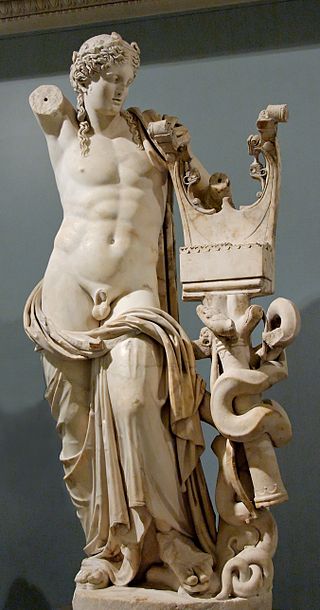
The Apollo of Cyrene is a large Roman statue of Apollo found at the ancient city of Cyrene, Libya. It was unearthed at the site along with a great number of other ancient sculptures and inscriptions which were presented to the British Museum in 1861.
The Mahdia Museum is a museum in Tunisia specialising in Tunisian archaeology and heritage. It is located in the city of Mahdia.

The Museum of Ancient Art in Aarhus, Denmark is museum dedicated to the ancient art and cultural history of the mediterranean countries, in particular Ancient Greece, Etruscan civilization and Ancient Rome. The museum is situated in the university campus in the district Midtbyen.

The Biblioteca Oliveriana is a public library located in the Palazzo Almerici on via Mazza in the town of Pesaro, region of Marche, Italy. It shares the building with the Museo Oliveriano, an archaeology museum with which it shares a common history.
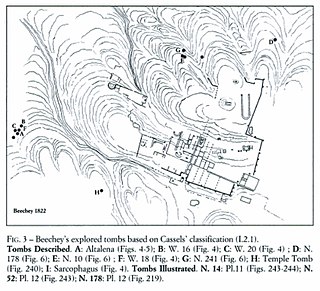
The Necropolis of Cyrene is a necropolis located between Cyrene, Libya and the ancient port of Apollonia, at the western slope of the Wadi Haleg Shaloof hill. It is around 10 square kilometres in size. With terraced archaic tombs, the cemetery is near the ancient road to Apollonia. The necropolis is today partially lost, parts were bulldozed in 2013. The UNESCO classified the site in 1982 as a World Heritage Site, and added Cyrene in 2017 to its List of World Heritage in Danger.

Cyrene Antiquity Museum is an archaeological museum located in Shahhat, Libya. It contains several statues and mosaics from the ancient Greek and later Roman city Cyrene.